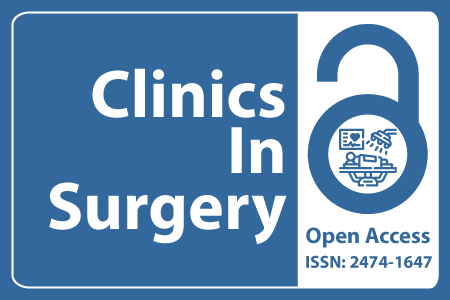
Journal Basic Info
- Impact Factor: 1.995**
- H-Index: 8
- ISSN: 2474-1647
- DOI: 10.25107/2474-1647
Major Scope
- General Surgery
- Minimally Invasive Surgery
- Breast Surgery
- Neurological Surgery
- Orthopaedic Surgery
- Emergency Surgery
- Endocrine Surgery
- Thoracic Surgery
Abstract
Citation: Clin Surg. 2021;6(1):3297.Research Article | Open Access
Cross-Clamp Technique and Incidence of Stroke after Coronary Artery Bypass Grafting: Know and Respect the Aorta Principle
Giorgio Mastroiacovo1#*, Marco Gennari1#, Ilaria Giambuzzi1, Sergio Pirola1, Giuseppe Nanci1, Alice Bonomi2, Gabriele Egidy Assenza3, Gianluca Polvani1,4 and Marco Agrifoglio1,4
1Department of Cardiovascular Surgery, IRCCS Centro Cardiologico Monzino, Italy
2Department of Statistics, IRCCS Centro Cardiologico Monzino Milan, Italy
3Departement of Pediatric Cardiology and Adult Congenital Heart Disease, Sant’Orsola Malpighi Hospital, Italy
4Department of Biomedical, Surgical and Dental Sciences, University of Milan, Italy
#These authors contributed equally to this work
*Correspondance to: Giorgio Mastroiacovo
PDF Full Text DOI: 10.25107/2474-1647.3297
Abstract
Objectives: One of the most severe and devastating complications following Coronary Artery Bypass Grafting (CABG) are cerebrovascular accidents. Atherosclerotic disease of the ascending aorta and epi-aortic trunks has been considered the most probable cause of cerebral embolization during CABG due to aortic manipulation and clamping. The aim of this study is to investigate if single or double aortic clamping may impact the incidence of neurological events. Methods: This is a retrospective study which includes a consecutive series of patients who underwent CABG from a single CABG-experienced surgeon at our Institution from March 2006 to December 2012. Patients were divided into two homogenous groups based on the surgical technique adopted: Single-Aortic Clamping (SAC) (118 patients) and Double Aortic Clamp (DAC) (133 pt). Results: Median surgical time was statistically longer for the DAC group than for the SAC group (p=0.015), but no significant differences were found for the primary outcomes of stroke and transient ischemic attack. The two groups presented a similar 30-day survival. The follow-up was completed at 82% (median 11 years). The Kaplan-Meier estimates a survival at 11 years of 81% and 88% for the DAC and SAC group, respectively. Conclusion: Incidence of stroke seems to be independent from cross-clamping technique and, more generally, we could infer that the global rate of stroke after CABG in low to moderate risk patients is probably more influenced by other factors that further studies need to address. Moreover, the appearance of the aorta at the time of surgery is crucial to analyze to better personalize the strategy.
Keywords
Cite the article
Mastroiacovo G, Gennari M, Giambuzzi I, Pirola S, Nanci G, Bonomi A, et al. Cross-Clamp Technique and Incidence of Stroke after Coronary Artery Bypass Grafting: Know and Respect the Aorta Principle. Clin Surg. 2021; 6: 3297.













